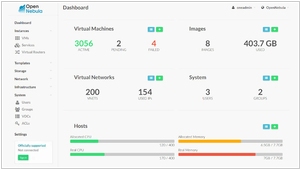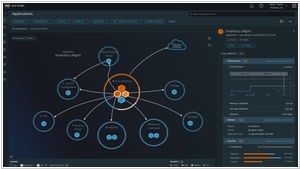OpenNebula vs VMware Aria
July 30, 2023 | Author: Michael Stromann
See also:
Top 10 Cloud Management platforms
Top 10 Cloud Management platforms
OpenNebula and VMware Aria are both prominent cloud management platforms, but they differ significantly in their architectures, target audiences, and licensing models. OpenNebula, an open-source cloud management platform, provides a comprehensive solution for managing virtualized data centers and building private, public, or hybrid clouds. Its open nature allows for extensive customization and integration with multiple hypervisors and storage technologies, making it a preferred choice for organizations seeking vendor-neutral, cost-effective solutions. In contrast, VMware Aria, developed by VMware, focuses on delivering cloud-native infrastructure and services specifically tailored to VMware environments. It capitalizes on VMware's vast expertise in virtualization and containerization technologies, making it an ideal fit for businesses already invested in VMware's ecosystem seeking a seamless cloud transition.
Another crucial distinction between OpenNebula and VMware Aria lies in their feature sets and deployment models. OpenNebula's approach emphasizes simplicity and flexibility, allowing users to build clouds from scratch with a minimalistic design philosophy. This can be beneficial for organizations that prefer more control and the ability to fine-tune their cloud infrastructure. Conversely, VMware Aria leans towards streamlining cloud adoption for existing VMware users. It integrates seamlessly with vSphere, VMware's virtualization platform, and Tanzu, their Kubernetes management solution, providing a cohesive environment for both virtual machines and containerized applications. This tight integration makes VMware Aria a compelling choice for businesses looking to extend their VMware investments into the cloud-native realm with ease.
Lastly, the licensing and cost structures of OpenNebula and VMware Aria differ substantially. As an open-source platform, OpenNebula is free to use and modify, presenting a cost-efficient option for budget-conscious organizations. Additionally, the open community contributes to ongoing improvements and enhancements. In contrast, VMware Aria follows a commercial licensing model with subscription-based pricing, which includes access to VMware's support and services. While the added cost may deter some smaller organizations, larger enterprises benefit from the robust support and enterprise-grade features that come with VMware's backing. Ultimately, the choice between OpenNebula and VMware Aria hinges on factors such as organizational size, existing infrastructure, budget considerations, and the level of customization required, each catering to different cloud management needs.
See also: Top 10 Cloud Management platforms
Another crucial distinction between OpenNebula and VMware Aria lies in their feature sets and deployment models. OpenNebula's approach emphasizes simplicity and flexibility, allowing users to build clouds from scratch with a minimalistic design philosophy. This can be beneficial for organizations that prefer more control and the ability to fine-tune their cloud infrastructure. Conversely, VMware Aria leans towards streamlining cloud adoption for existing VMware users. It integrates seamlessly with vSphere, VMware's virtualization platform, and Tanzu, their Kubernetes management solution, providing a cohesive environment for both virtual machines and containerized applications. This tight integration makes VMware Aria a compelling choice for businesses looking to extend their VMware investments into the cloud-native realm with ease.
Lastly, the licensing and cost structures of OpenNebula and VMware Aria differ substantially. As an open-source platform, OpenNebula is free to use and modify, presenting a cost-efficient option for budget-conscious organizations. Additionally, the open community contributes to ongoing improvements and enhancements. In contrast, VMware Aria follows a commercial licensing model with subscription-based pricing, which includes access to VMware's support and services. While the added cost may deter some smaller organizations, larger enterprises benefit from the robust support and enterprise-grade features that come with VMware's backing. Ultimately, the choice between OpenNebula and VMware Aria hinges on factors such as organizational size, existing infrastructure, budget considerations, and the level of customization required, each catering to different cloud management needs.
See also: Top 10 Cloud Management platforms





